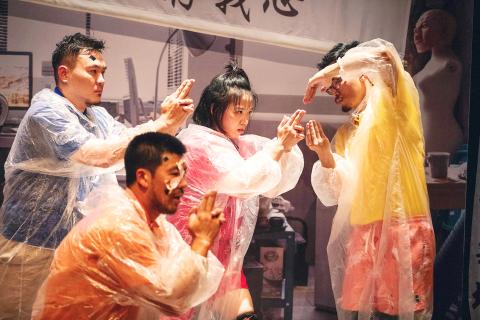The myth of the Paris premiere of Igor Stravinsky’s ballet Le Sacre du Printemps (The Rite of Spring) for Serge Diaghilev’s Ballets Russes, on May 29, 1913, was that it sparked a riot and caused a scandal.
Whether there really was a riot, or just an uproar, and what caused the offense — Stravinsky’s use of dissonant chords and a pulsating rhythm, choreographer Vaslav Nijinsky’s jerky, unusual steps or the celebration of Russian paganism and ritual sacrifice — remains a subject of academic debate.
What is clear is that Stravinsky’s score and the idea of ritual sacrifice have continued to inspire choreographers and other artists in the decades since.

Photo courtesy of Lee Chia-yeh
It inspired the program team of the National Theater Concert Hall to make The Rite of Spring the focus for this year’s Innovation Series of Dance, featuring works by six choreographers over three programs in the National Experimental Theater.
The series opened on June 2 with the Dick Wong — Dance Theatre (黃大徽 舞蹈劇場) from Hong Kong, which performed Wong’s 2016 exploration of the art of creation, using portions of Stravinsky’s score and titled of course, The Rite of Spring (春之祭).
This weekend is the turn for three Taiwanese choreographers, Lin Su-lien (林素蓮), Liu Yan-cheng (劉彥成) and Liu Kuan-hsiang (劉冠詳), who will present a Mixed Program of short works.

Credit: Photo courtesy of Lee Chia-yeh
Lin and Liu Yan-cheng are veterans of the dance Innovation Series, with Lin’s No Man’s Land (福吉三街) one of the shows in 2016, while Liu’s Monster (怪獸) was part of last year’s mixed program.
Liu Kuan-hsiang has been riding on a wave the past few years, with his 2016 work Kids (我知道的太多了), winning the Performing Arts Award at the 15th Annual Taishin Arts Award, a commission from the Cloud Gate Theater that led to last year’s Karma (棄者), and a work in Cloud Gate 2’s (雲門2) Spring Riot program this year, Superbeing (變態).
The trio were asked to create pieces that gave their interpretation of doomsday sacrifice or post-sacrifice awareness.
Lin’s work, Hey! Lady, Please Look at Me (小姐免驚), is set on four dancers, with six more “special performers.”
Liu Yan-cheng’s piece, The End of Journey (垃圾), is a duet for himself and choreographer/dancer Tien Hsiao-tzu (田孝慈).
Liu Kuan-hsiang’s All About Brutality (酷刑姿勢練習) is also set on four dancers.
This year’s Innovation Series will end with French choreographer Xavier le Roy’s 2007 solo, Le Sacre du Printemps, which opens on July 6, and asks the question: Do conductors, through their movements, lead an orchestra or is it the music leading the conductor?
■ 2018 Innovation Series — Mixed Program (微舞作 — 林素蓮、劉彥成、劉冠詳): Tonight and tomorrow at 7:30pm, tomorrow and Sunday at 2:30pm; National Experimental Theater (國家實驗劇場), 21-1 Zhongshan S Rd, Taipei City (台北市中山南路21-1號)
■ Tickets are NT$800, available at NTCH box offices, online at www.artsticket.com and convenience store ticket kiosks. Tonight and Sunday’s shows are sold out

The canonical shot of an East Asian city is a night skyline studded with towering apartment and office buildings, bright with neon and plastic signage, a landscape of energy and modernity. Another classic image is the same city seen from above, in which identical apartment towers march across the city, spilling out over nearby geography, like stylized soldiers colonizing new territory in a board game. Densely populated dynamic conurbations of money, technological innovation and convenience, it is hard to see the cities of East Asia as what they truly are: necropolises. Why is this? The East Asian development model, with

June 16 to June 22 The following flyer appeared on the streets of Hsinchu on June 12, 1895: “Taipei has already fallen to the Japanese barbarians, who have brought great misery to our land and people. We heard that the Japanese occupiers will tax our gardens, our houses, our bodies, and even our chickens, dogs, cows and pigs. They wear their hair wild, carve their teeth, tattoo their foreheads, wear strange clothes and speak a strange language. How can we be ruled by such people?” Posted by civilian militia leader Wu Tang-hsing (吳湯興), it was a call to arms to retake

This is a deeply unsettling period in Taiwan. Uncertainties are everywhere while everyone waits for a small army of other shoes to drop on nearly every front. During challenging times, interesting political changes can happen, yet all three major political parties are beset with scandals, strife and self-inflicted wounds. As the ruling party, the Democratic Progressive Party (DPP) is held accountable for not only the challenges to the party, but also the nation. Taiwan is geopolitically and economically under threat. Domestically, the administration is under siege by the opposition-controlled legislature and growing discontent with what opponents characterize as arrogant, autocratic

When Lisa, 20, laces into her ultra-high heels for her shift at a strip club in Ukraine’s Kharkiv, she knows that aside from dancing, she will have to comfort traumatized soldiers. Since Russia’s 2022 invasion, exhausted troops are the main clientele of the Flash Dancers club in the center of the northeastern city, just 20 kilometers from Russian forces. For some customers, it provides an “escape” from the war, said Valerya Zavatska — a 25-year-old law graduate who runs the club with her mother, an ex-dancer. But many are not there just for the show. They “want to talk about what hurts,” she